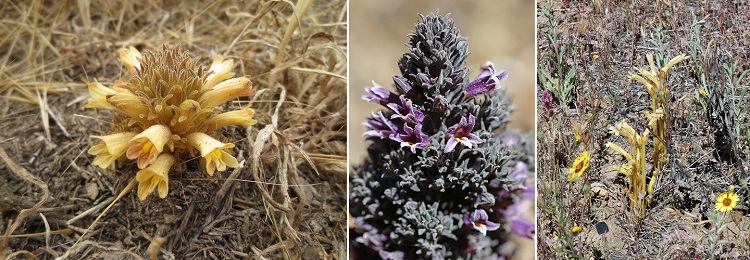Taxon of the Week: Orobanche

Left: Orobanche parishii ssp. brachyloba (CRPR 4) by Katie Ferguson; Middle: Orobanche bulbosa, (common) by Kristi Lazar; Right: Orobanche fasciculata (common) by Katie Ferguson
These fascinating parasitic plants are always a treat to find in the wild with their alien-looking flower stalks emerging straight from the ground and no leaves to be seen.
The genus Orobanche is home to parasitic plants that lack chlorophyll, and therefore completely depend on their host plant for nutrition. Some species are only able to parasitize a single host species, while others can survive on a wide variety of hosts. If you spot one, be sure to note the other plant species growing nearby so you can identify potential hosts.
Orobanche are often referred to by their common name “broomrape” which comes from the English word broom (referring to the shrubby plants in the pea family that broomrapes often parasitize) and the Latin word “rapum” (which roughly translates to “tuber”). Although recent phylogenetic studies now place all broomrapes found in California into the genus Aphyllon, for now CNDDB still uses the former genus name Orobanche.
CNDDB currently tracks four species of Orobanche, including Orobanche parishii ssp. brachyloba (California Rare Plant Rank 4.2). O. parishii ssp. brachyloba is found in coastal bluff scrub and coastal dunes on the Channel Islands and southern coast of California, with its range slightly extending into Mexico. It is most commonly found near Isocoma menziesii, which is presumed to be the preferred host plant for this species. The few remaining mainland populations are highly threatened by coastal urban development; however it is found to be widespread on several of the Channel Islands. If you see O. parishii ssp. brachyloba or any other rare broomrapes in the wild, be sure to submit your observation with our  CNDDB Online Field Survey Form!
CNDDB Online Field Survey Form!